Holmes Institute HI6006: Competitive Strategy Analysis of Woolworths
VerifiedAdded on 2022/09/15
|8
|1946
|23
Essay
AI Summary
This essay provides a comprehensive analysis of Woolworth's competitive strategy, utilizing several key strategic development tools. It begins with a SWOT analysis, evaluating the company's internal strengths and weaknesses, as well as external opportunities and threats. The essay then applies Porter's Five Forces model to assess the competitive intensity within the retail market, considering factors such as the threat of new entrants, the bargaining power of suppliers and buyers, the threat of substitutes, and the rivalry among existing competitors. Finally, a PESTLE analysis is conducted to examine the broader macro-environmental factors influencing Woolworth, including political, economic, social, technological, legal, and environmental aspects. The analysis aims to provide insights into Woolworth's strategic position and potential future developments.
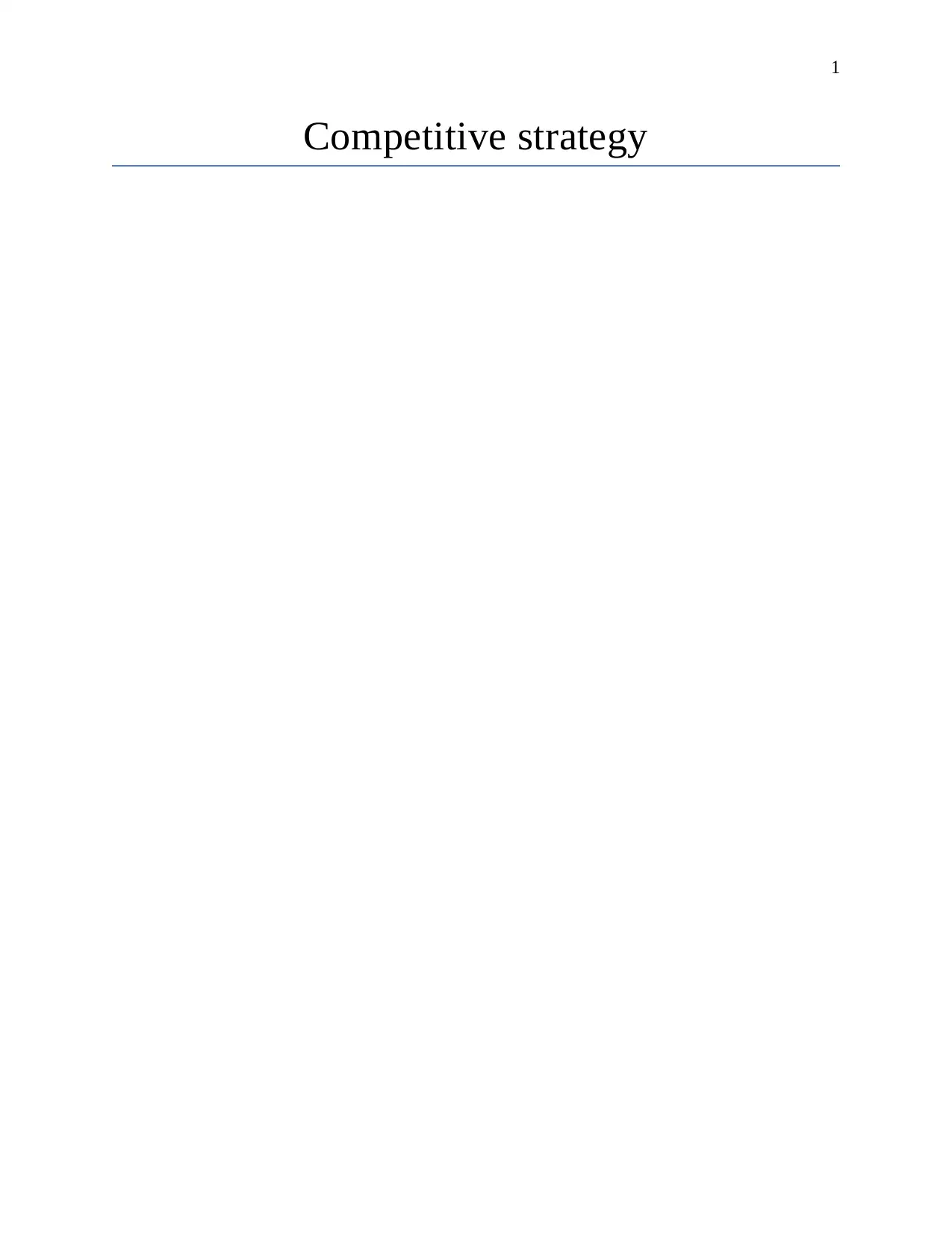
1
Competitive strategy
Competitive strategy
Paraphrase This Document
Need a fresh take? Get an instant paraphrase of this document with our AI Paraphraser
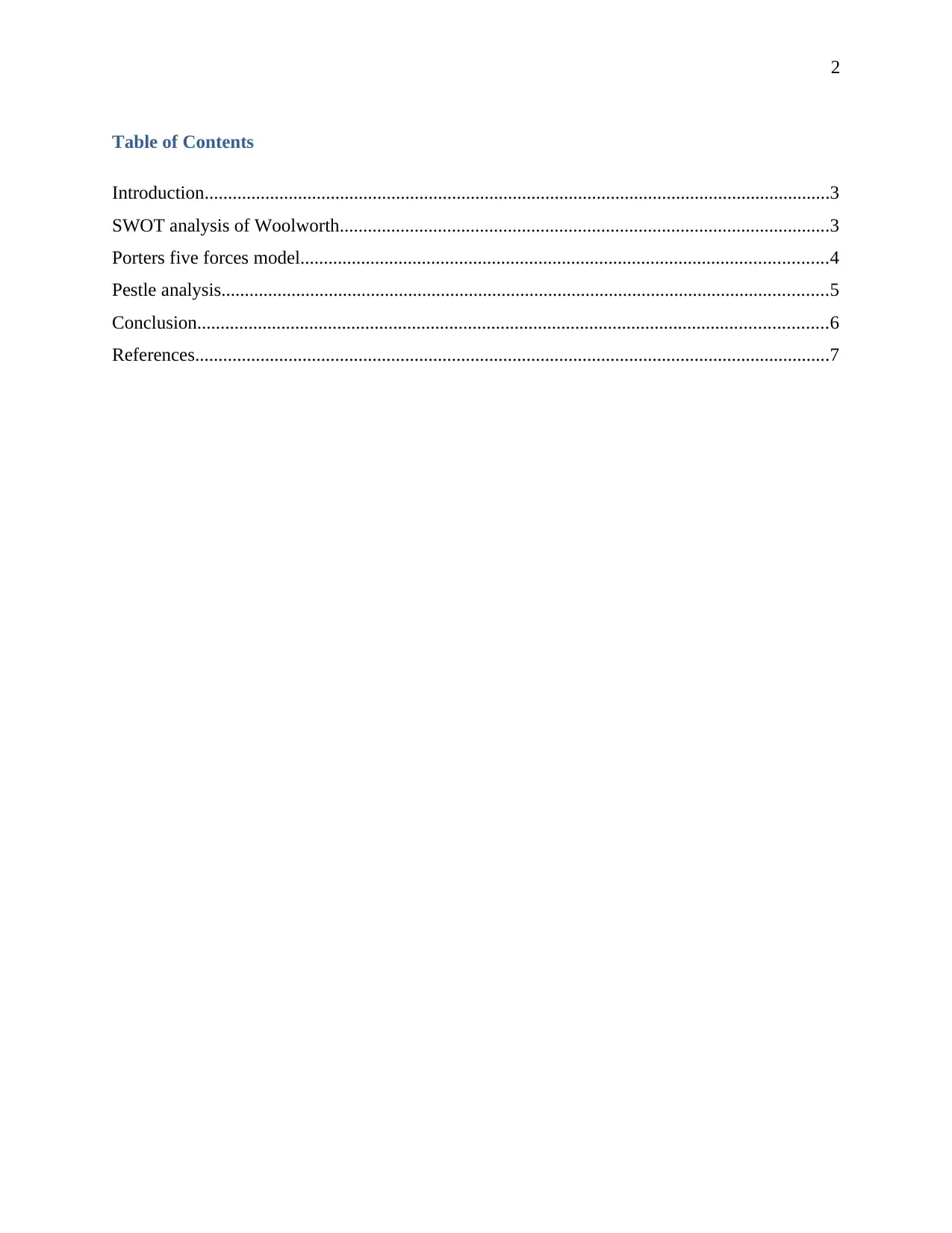
2
Table of Contents
Introduction......................................................................................................................................3
SWOT analysis of Woolworth.........................................................................................................3
Porters five forces model.................................................................................................................4
Pestle analysis..................................................................................................................................5
Conclusion.......................................................................................................................................6
References........................................................................................................................................7
Table of Contents
Introduction......................................................................................................................................3
SWOT analysis of Woolworth.........................................................................................................3
Porters five forces model.................................................................................................................4
Pestle analysis..................................................................................................................................5
Conclusion.......................................................................................................................................6
References........................................................................................................................................7
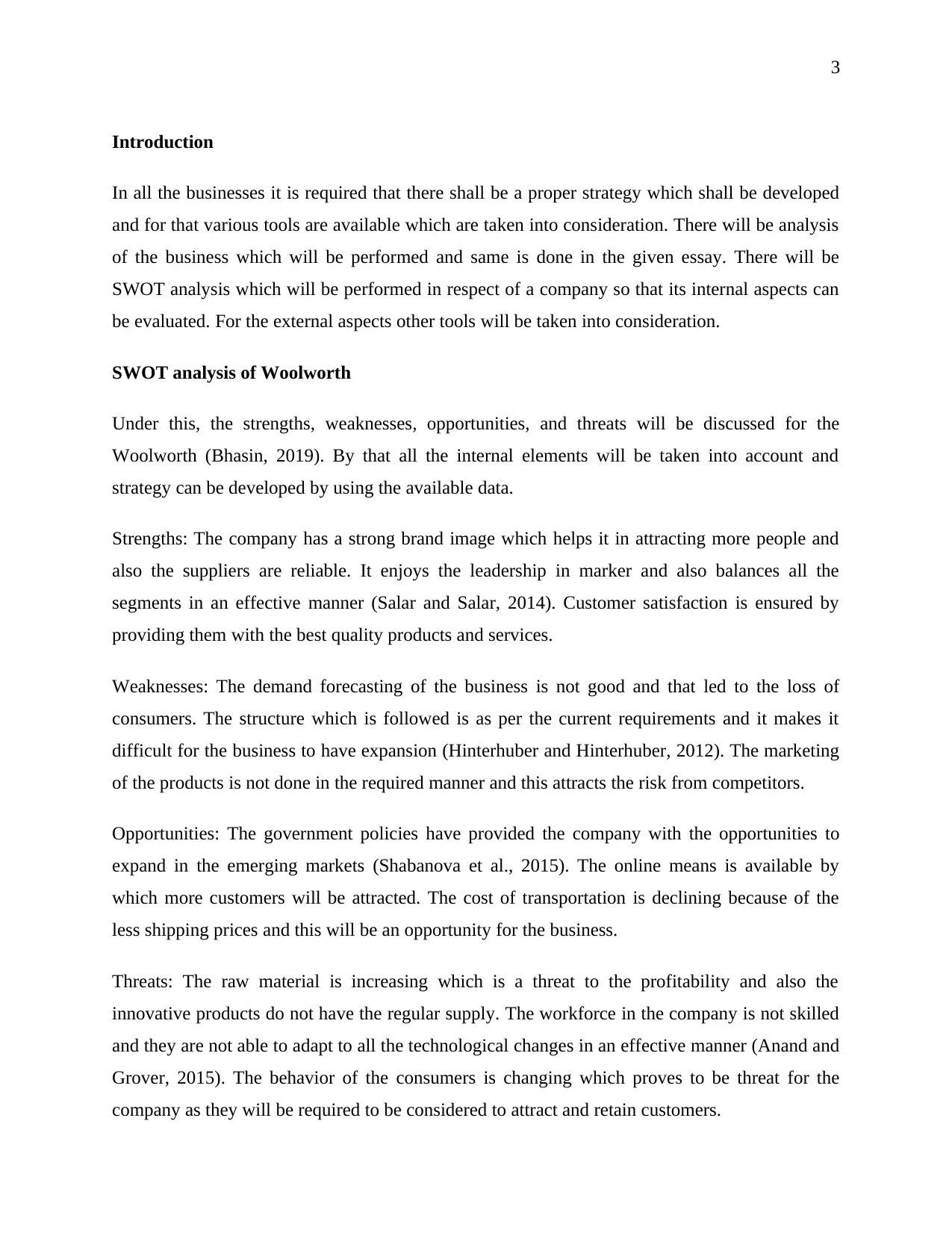
3
Introduction
In all the businesses it is required that there shall be a proper strategy which shall be developed
and for that various tools are available which are taken into consideration. There will be analysis
of the business which will be performed and same is done in the given essay. There will be
SWOT analysis which will be performed in respect of a company so that its internal aspects can
be evaluated. For the external aspects other tools will be taken into consideration.
SWOT analysis of Woolworth
Under this, the strengths, weaknesses, opportunities, and threats will be discussed for the
Woolworth (Bhasin, 2019). By that all the internal elements will be taken into account and
strategy can be developed by using the available data.
Strengths: The company has a strong brand image which helps it in attracting more people and
also the suppliers are reliable. It enjoys the leadership in marker and also balances all the
segments in an effective manner (Salar and Salar, 2014). Customer satisfaction is ensured by
providing them with the best quality products and services.
Weaknesses: The demand forecasting of the business is not good and that led to the loss of
consumers. The structure which is followed is as per the current requirements and it makes it
difficult for the business to have expansion (Hinterhuber and Hinterhuber, 2012). The marketing
of the products is not done in the required manner and this attracts the risk from competitors.
Opportunities: The government policies have provided the company with the opportunities to
expand in the emerging markets (Shabanova et al., 2015). The online means is available by
which more customers will be attracted. The cost of transportation is declining because of the
less shipping prices and this will be an opportunity for the business.
Threats: The raw material is increasing which is a threat to the profitability and also the
innovative products do not have the regular supply. The workforce in the company is not skilled
and they are not able to adapt to all the technological changes in an effective manner (Anand and
Grover, 2015). The behavior of the consumers is changing which proves to be threat for the
company as they will be required to be considered to attract and retain customers.
Introduction
In all the businesses it is required that there shall be a proper strategy which shall be developed
and for that various tools are available which are taken into consideration. There will be analysis
of the business which will be performed and same is done in the given essay. There will be
SWOT analysis which will be performed in respect of a company so that its internal aspects can
be evaluated. For the external aspects other tools will be taken into consideration.
SWOT analysis of Woolworth
Under this, the strengths, weaknesses, opportunities, and threats will be discussed for the
Woolworth (Bhasin, 2019). By that all the internal elements will be taken into account and
strategy can be developed by using the available data.
Strengths: The company has a strong brand image which helps it in attracting more people and
also the suppliers are reliable. It enjoys the leadership in marker and also balances all the
segments in an effective manner (Salar and Salar, 2014). Customer satisfaction is ensured by
providing them with the best quality products and services.
Weaknesses: The demand forecasting of the business is not good and that led to the loss of
consumers. The structure which is followed is as per the current requirements and it makes it
difficult for the business to have expansion (Hinterhuber and Hinterhuber, 2012). The marketing
of the products is not done in the required manner and this attracts the risk from competitors.
Opportunities: The government policies have provided the company with the opportunities to
expand in the emerging markets (Shabanova et al., 2015). The online means is available by
which more customers will be attracted. The cost of transportation is declining because of the
less shipping prices and this will be an opportunity for the business.
Threats: The raw material is increasing which is a threat to the profitability and also the
innovative products do not have the regular supply. The workforce in the company is not skilled
and they are not able to adapt to all the technological changes in an effective manner (Anand and
Grover, 2015). The behavior of the consumers is changing which proves to be threat for the
company as they will be required to be considered to attract and retain customers.
⊘ This is a preview!⊘
Do you want full access?
Subscribe today to unlock all pages.

Trusted by 1+ million students worldwide
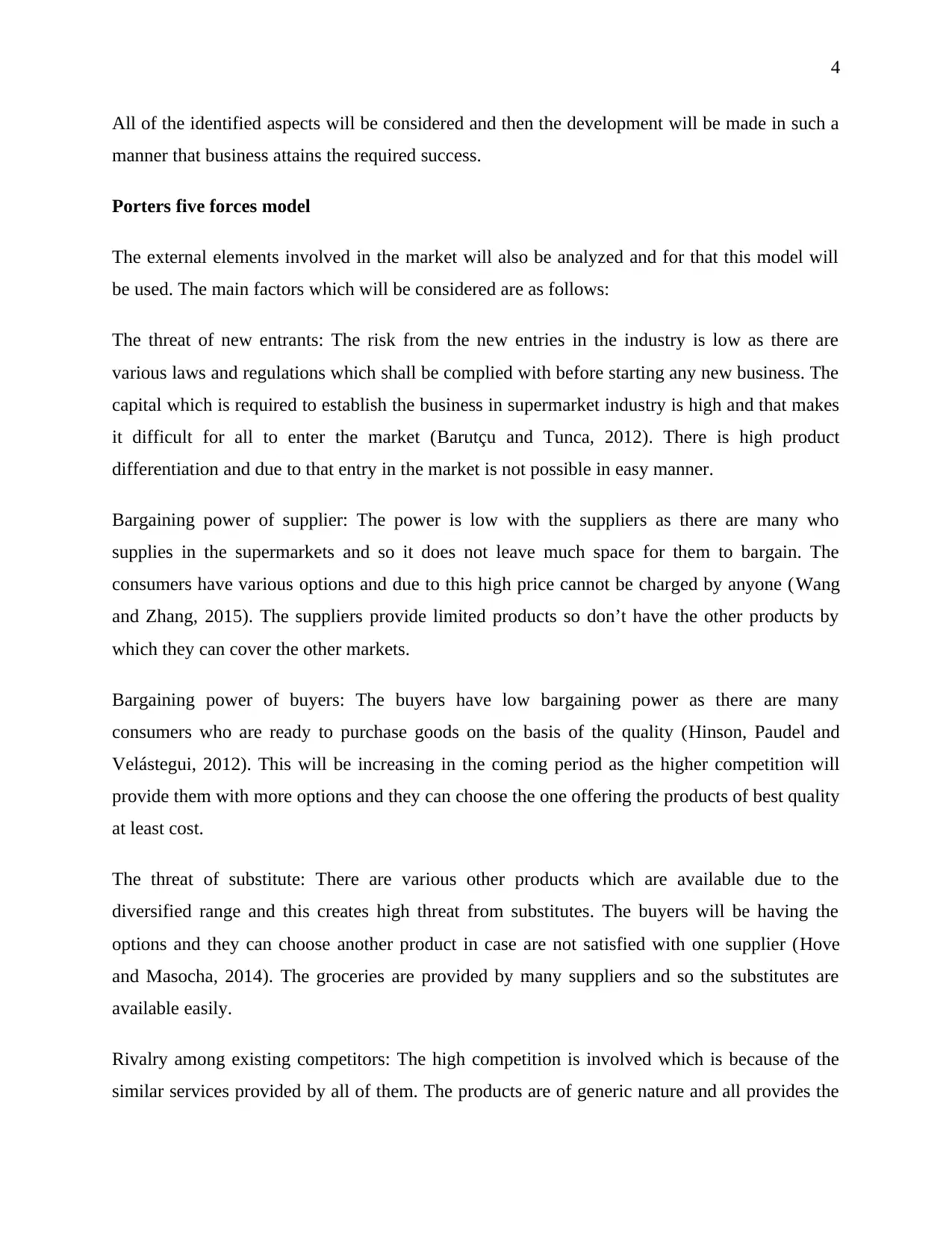
4
All of the identified aspects will be considered and then the development will be made in such a
manner that business attains the required success.
Porters five forces model
The external elements involved in the market will also be analyzed and for that this model will
be used. The main factors which will be considered are as follows:
The threat of new entrants: The risk from the new entries in the industry is low as there are
various laws and regulations which shall be complied with before starting any new business. The
capital which is required to establish the business in supermarket industry is high and that makes
it difficult for all to enter the market (Barutçu and Tunca, 2012). There is high product
differentiation and due to that entry in the market is not possible in easy manner.
Bargaining power of supplier: The power is low with the suppliers as there are many who
supplies in the supermarkets and so it does not leave much space for them to bargain. The
consumers have various options and due to this high price cannot be charged by anyone (Wang
and Zhang, 2015). The suppliers provide limited products so don’t have the other products by
which they can cover the other markets.
Bargaining power of buyers: The buyers have low bargaining power as there are many
consumers who are ready to purchase goods on the basis of the quality (Hinson, Paudel and
Velástegui, 2012). This will be increasing in the coming period as the higher competition will
provide them with more options and they can choose the one offering the products of best quality
at least cost.
The threat of substitute: There are various other products which are available due to the
diversified range and this creates high threat from substitutes. The buyers will be having the
options and they can choose another product in case are not satisfied with one supplier (Hove
and Masocha, 2014). The groceries are provided by many suppliers and so the substitutes are
available easily.
Rivalry among existing competitors: The high competition is involved which is because of the
similar services provided by all of them. The products are of generic nature and all provides the
All of the identified aspects will be considered and then the development will be made in such a
manner that business attains the required success.
Porters five forces model
The external elements involved in the market will also be analyzed and for that this model will
be used. The main factors which will be considered are as follows:
The threat of new entrants: The risk from the new entries in the industry is low as there are
various laws and regulations which shall be complied with before starting any new business. The
capital which is required to establish the business in supermarket industry is high and that makes
it difficult for all to enter the market (Barutçu and Tunca, 2012). There is high product
differentiation and due to that entry in the market is not possible in easy manner.
Bargaining power of supplier: The power is low with the suppliers as there are many who
supplies in the supermarkets and so it does not leave much space for them to bargain. The
consumers have various options and due to this high price cannot be charged by anyone (Wang
and Zhang, 2015). The suppliers provide limited products so don’t have the other products by
which they can cover the other markets.
Bargaining power of buyers: The buyers have low bargaining power as there are many
consumers who are ready to purchase goods on the basis of the quality (Hinson, Paudel and
Velástegui, 2012). This will be increasing in the coming period as the higher competition will
provide them with more options and they can choose the one offering the products of best quality
at least cost.
The threat of substitute: There are various other products which are available due to the
diversified range and this creates high threat from substitutes. The buyers will be having the
options and they can choose another product in case are not satisfied with one supplier (Hove
and Masocha, 2014). The groceries are provided by many suppliers and so the substitutes are
available easily.
Rivalry among existing competitors: The high competition is involved which is because of the
similar services provided by all of them. The products are of generic nature and all provides the
Paraphrase This Document
Need a fresh take? Get an instant paraphrase of this document with our AI Paraphraser
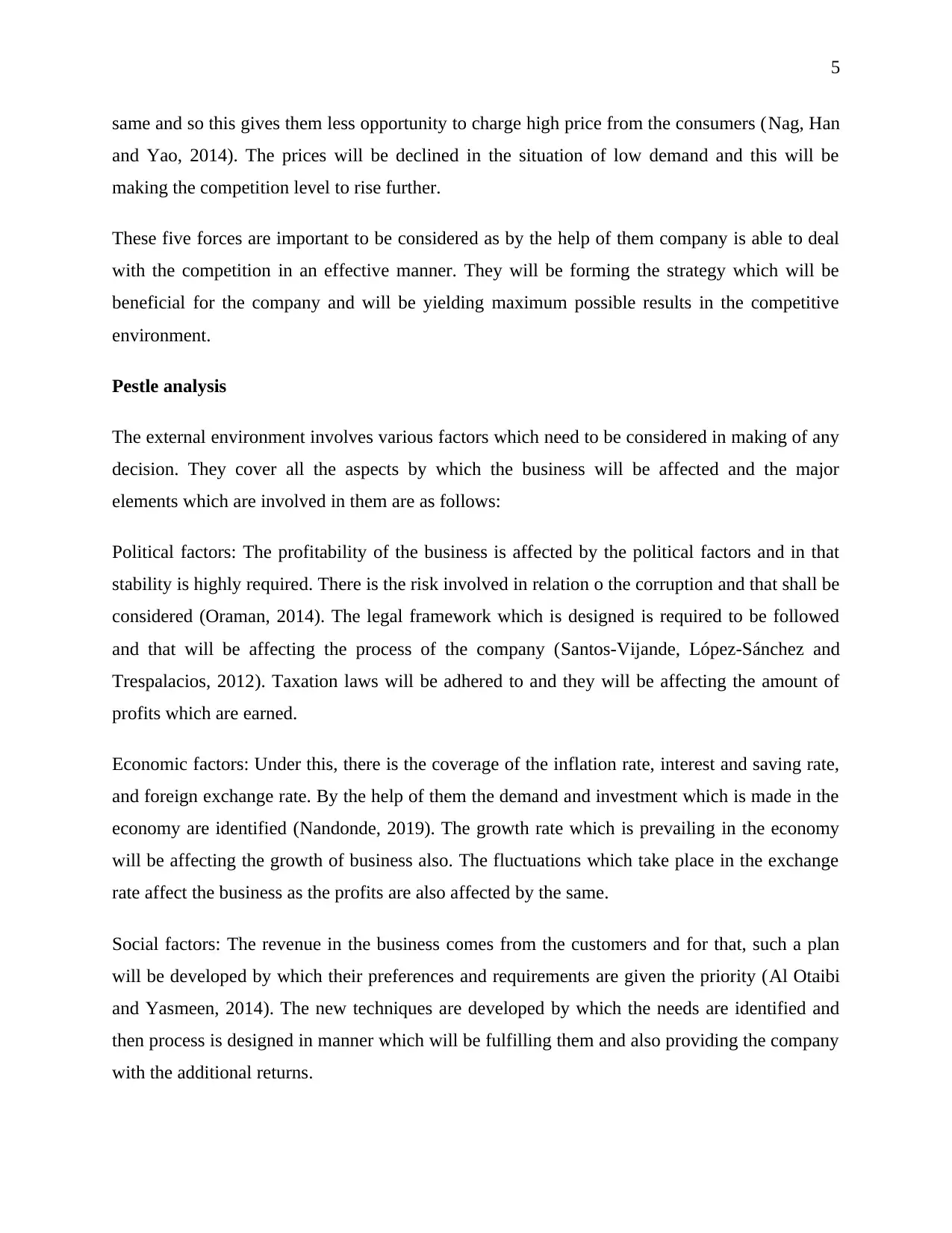
5
same and so this gives them less opportunity to charge high price from the consumers (Nag, Han
and Yao, 2014). The prices will be declined in the situation of low demand and this will be
making the competition level to rise further.
These five forces are important to be considered as by the help of them company is able to deal
with the competition in an effective manner. They will be forming the strategy which will be
beneficial for the company and will be yielding maximum possible results in the competitive
environment.
Pestle analysis
The external environment involves various factors which need to be considered in making of any
decision. They cover all the aspects by which the business will be affected and the major
elements which are involved in them are as follows:
Political factors: The profitability of the business is affected by the political factors and in that
stability is highly required. There is the risk involved in relation o the corruption and that shall be
considered (Oraman, 2014). The legal framework which is designed is required to be followed
and that will be affecting the process of the company (Santos-Vijande, López-Sánchez and
Trespalacios, 2012). Taxation laws will be adhered to and they will be affecting the amount of
profits which are earned.
Economic factors: Under this, there is the coverage of the inflation rate, interest and saving rate,
and foreign exchange rate. By the help of them the demand and investment which is made in the
economy are identified (Nandonde, 2019). The growth rate which is prevailing in the economy
will be affecting the growth of business also. The fluctuations which take place in the exchange
rate affect the business as the profits are also affected by the same.
Social factors: The revenue in the business comes from the customers and for that, such a plan
will be developed by which their preferences and requirements are given the priority (Al Otaibi
and Yasmeen, 2014). The new techniques are developed by which the needs are identified and
then process is designed in manner which will be fulfilling them and also providing the company
with the additional returns.
same and so this gives them less opportunity to charge high price from the consumers (Nag, Han
and Yao, 2014). The prices will be declined in the situation of low demand and this will be
making the competition level to rise further.
These five forces are important to be considered as by the help of them company is able to deal
with the competition in an effective manner. They will be forming the strategy which will be
beneficial for the company and will be yielding maximum possible results in the competitive
environment.
Pestle analysis
The external environment involves various factors which need to be considered in making of any
decision. They cover all the aspects by which the business will be affected and the major
elements which are involved in them are as follows:
Political factors: The profitability of the business is affected by the political factors and in that
stability is highly required. There is the risk involved in relation o the corruption and that shall be
considered (Oraman, 2014). The legal framework which is designed is required to be followed
and that will be affecting the process of the company (Santos-Vijande, López-Sánchez and
Trespalacios, 2012). Taxation laws will be adhered to and they will be affecting the amount of
profits which are earned.
Economic factors: Under this, there is the coverage of the inflation rate, interest and saving rate,
and foreign exchange rate. By the help of them the demand and investment which is made in the
economy are identified (Nandonde, 2019). The growth rate which is prevailing in the economy
will be affecting the growth of business also. The fluctuations which take place in the exchange
rate affect the business as the profits are also affected by the same.
Social factors: The revenue in the business comes from the customers and for that, such a plan
will be developed by which their preferences and requirements are given the priority (Al Otaibi
and Yasmeen, 2014). The new techniques are developed by which the needs are identified and
then process is designed in manner which will be fulfilling them and also providing the company
with the additional returns.
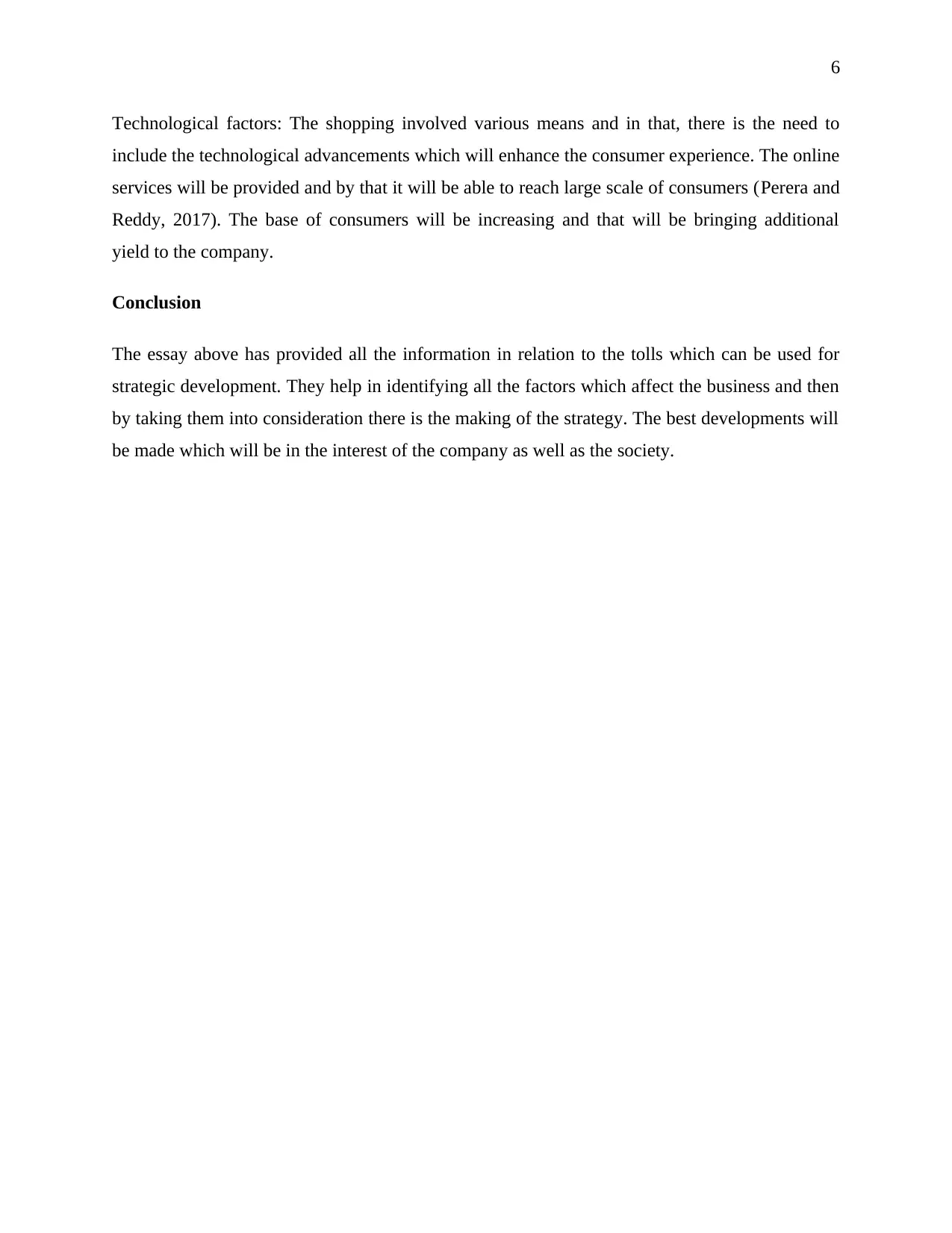
6
Technological factors: The shopping involved various means and in that, there is the need to
include the technological advancements which will enhance the consumer experience. The online
services will be provided and by that it will be able to reach large scale of consumers (Perera and
Reddy, 2017). The base of consumers will be increasing and that will be bringing additional
yield to the company.
Conclusion
The essay above has provided all the information in relation to the tolls which can be used for
strategic development. They help in identifying all the factors which affect the business and then
by taking them into consideration there is the making of the strategy. The best developments will
be made which will be in the interest of the company as well as the society.
Technological factors: The shopping involved various means and in that, there is the need to
include the technological advancements which will enhance the consumer experience. The online
services will be provided and by that it will be able to reach large scale of consumers (Perera and
Reddy, 2017). The base of consumers will be increasing and that will be bringing additional
yield to the company.
Conclusion
The essay above has provided all the information in relation to the tolls which can be used for
strategic development. They help in identifying all the factors which affect the business and then
by taking them into consideration there is the making of the strategy. The best developments will
be made which will be in the interest of the company as well as the society.
⊘ This is a preview!⊘
Do you want full access?
Subscribe today to unlock all pages.

Trusted by 1+ million students worldwide
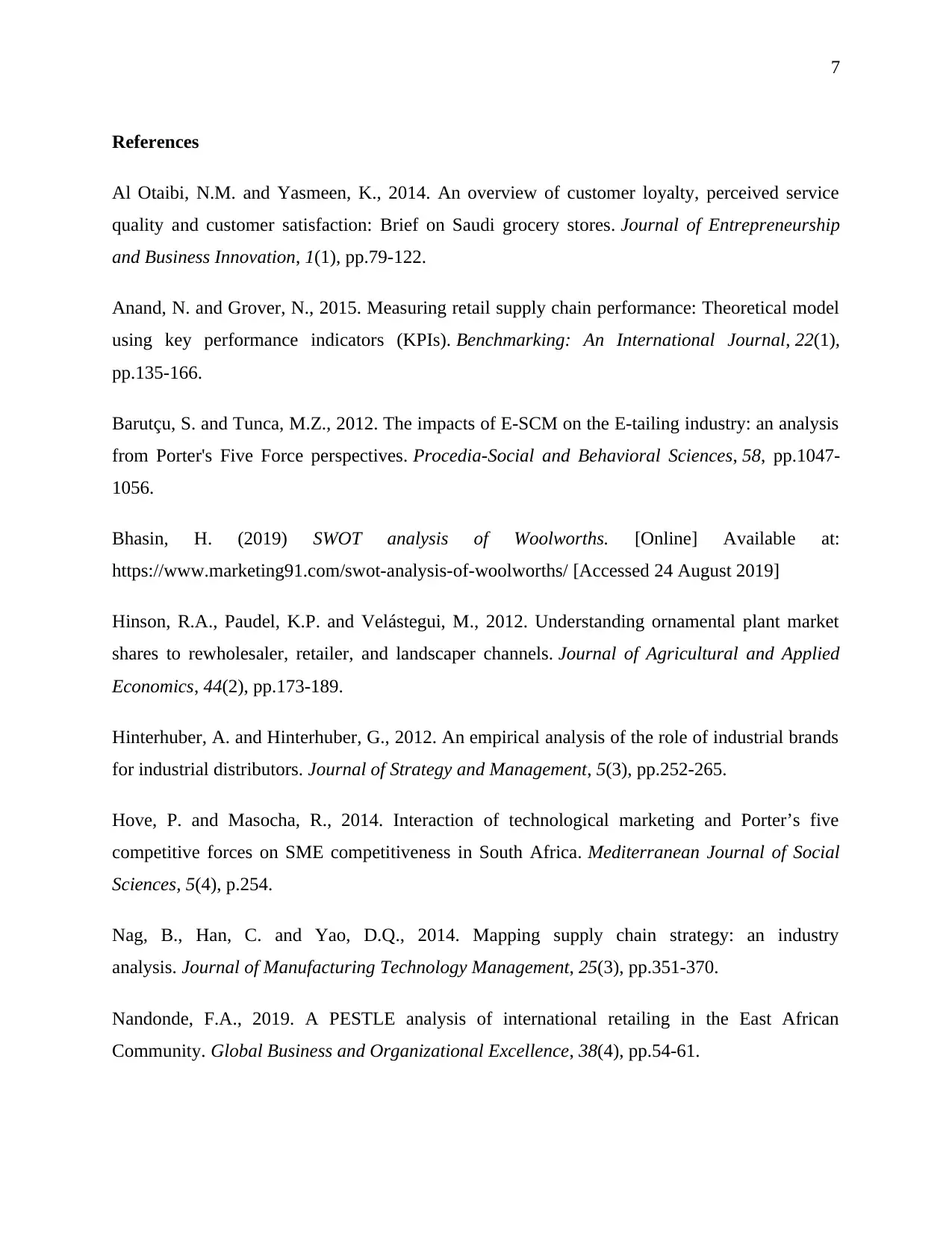
7
References
Al Otaibi, N.M. and Yasmeen, K., 2014. An overview of customer loyalty, perceived service
quality and customer satisfaction: Brief on Saudi grocery stores. Journal of Entrepreneurship
and Business Innovation, 1(1), pp.79-122.
Anand, N. and Grover, N., 2015. Measuring retail supply chain performance: Theoretical model
using key performance indicators (KPIs). Benchmarking: An International Journal, 22(1),
pp.135-166.
Barutçu, S. and Tunca, M.Z., 2012. The impacts of E-SCM on the E-tailing industry: an analysis
from Porter's Five Force perspectives. Procedia-Social and Behavioral Sciences, 58, pp.1047-
1056.
Bhasin, H. (2019) SWOT analysis of Woolworths. [Online] Available at:
https://www.marketing91.com/swot-analysis-of-woolworths/ [Accessed 24 August 2019]
Hinson, R.A., Paudel, K.P. and Velástegui, M., 2012. Understanding ornamental plant market
shares to rewholesaler, retailer, and landscaper channels. Journal of Agricultural and Applied
Economics, 44(2), pp.173-189.
Hinterhuber, A. and Hinterhuber, G., 2012. An empirical analysis of the role of industrial brands
for industrial distributors. Journal of Strategy and Management, 5(3), pp.252-265.
Hove, P. and Masocha, R., 2014. Interaction of technological marketing and Porter’s five
competitive forces on SME competitiveness in South Africa. Mediterranean Journal of Social
Sciences, 5(4), p.254.
Nag, B., Han, C. and Yao, D.Q., 2014. Mapping supply chain strategy: an industry
analysis. Journal of Manufacturing Technology Management, 25(3), pp.351-370.
Nandonde, F.A., 2019. A PESTLE analysis of international retailing in the East African
Community. Global Business and Organizational Excellence, 38(4), pp.54-61.
References
Al Otaibi, N.M. and Yasmeen, K., 2014. An overview of customer loyalty, perceived service
quality and customer satisfaction: Brief on Saudi grocery stores. Journal of Entrepreneurship
and Business Innovation, 1(1), pp.79-122.
Anand, N. and Grover, N., 2015. Measuring retail supply chain performance: Theoretical model
using key performance indicators (KPIs). Benchmarking: An International Journal, 22(1),
pp.135-166.
Barutçu, S. and Tunca, M.Z., 2012. The impacts of E-SCM on the E-tailing industry: an analysis
from Porter's Five Force perspectives. Procedia-Social and Behavioral Sciences, 58, pp.1047-
1056.
Bhasin, H. (2019) SWOT analysis of Woolworths. [Online] Available at:
https://www.marketing91.com/swot-analysis-of-woolworths/ [Accessed 24 August 2019]
Hinson, R.A., Paudel, K.P. and Velástegui, M., 2012. Understanding ornamental plant market
shares to rewholesaler, retailer, and landscaper channels. Journal of Agricultural and Applied
Economics, 44(2), pp.173-189.
Hinterhuber, A. and Hinterhuber, G., 2012. An empirical analysis of the role of industrial brands
for industrial distributors. Journal of Strategy and Management, 5(3), pp.252-265.
Hove, P. and Masocha, R., 2014. Interaction of technological marketing and Porter’s five
competitive forces on SME competitiveness in South Africa. Mediterranean Journal of Social
Sciences, 5(4), p.254.
Nag, B., Han, C. and Yao, D.Q., 2014. Mapping supply chain strategy: an industry
analysis. Journal of Manufacturing Technology Management, 25(3), pp.351-370.
Nandonde, F.A., 2019. A PESTLE analysis of international retailing in the East African
Community. Global Business and Organizational Excellence, 38(4), pp.54-61.
Paraphrase This Document
Need a fresh take? Get an instant paraphrase of this document with our AI Paraphraser
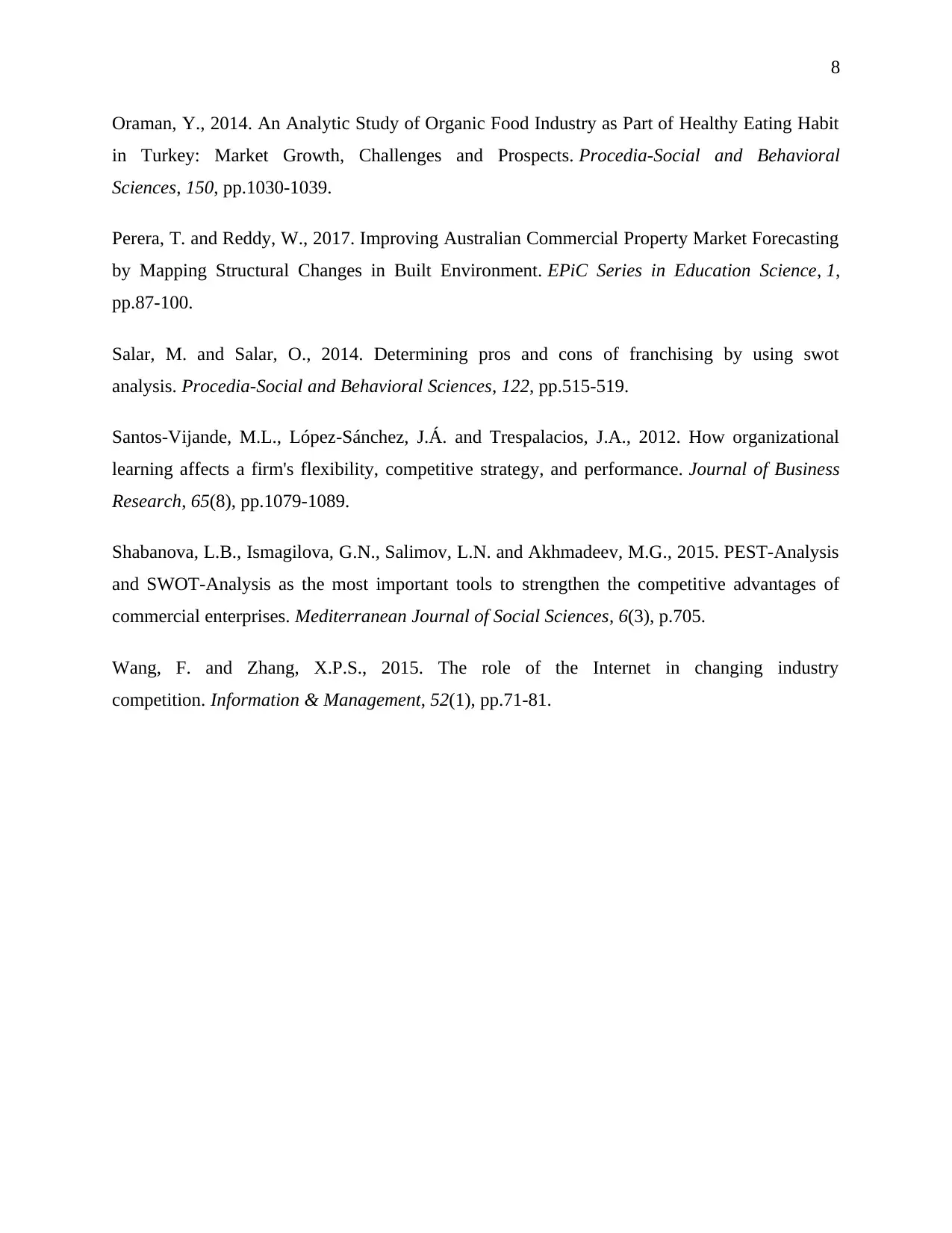
8
Oraman, Y., 2014. An Analytic Study of Organic Food Industry as Part of Healthy Eating Habit
in Turkey: Market Growth, Challenges and Prospects. Procedia-Social and Behavioral
Sciences, 150, pp.1030-1039.
Perera, T. and Reddy, W., 2017. Improving Australian Commercial Property Market Forecasting
by Mapping Structural Changes in Built Environment. EPiC Series in Education Science, 1,
pp.87-100.
Salar, M. and Salar, O., 2014. Determining pros and cons of franchising by using swot
analysis. Procedia-Social and Behavioral Sciences, 122, pp.515-519.
Santos-Vijande, M.L., López-Sánchez, J.Á. and Trespalacios, J.A., 2012. How organizational
learning affects a firm's flexibility, competitive strategy, and performance. Journal of Business
Research, 65(8), pp.1079-1089.
Shabanova, L.B., Ismagilova, G.N., Salimov, L.N. and Akhmadeev, M.G., 2015. PEST-Analysis
and SWOT-Analysis as the most important tools to strengthen the competitive advantages of
commercial enterprises. Mediterranean Journal of Social Sciences, 6(3), p.705.
Wang, F. and Zhang, X.P.S., 2015. The role of the Internet in changing industry
competition. Information & Management, 52(1), pp.71-81.
Oraman, Y., 2014. An Analytic Study of Organic Food Industry as Part of Healthy Eating Habit
in Turkey: Market Growth, Challenges and Prospects. Procedia-Social and Behavioral
Sciences, 150, pp.1030-1039.
Perera, T. and Reddy, W., 2017. Improving Australian Commercial Property Market Forecasting
by Mapping Structural Changes in Built Environment. EPiC Series in Education Science, 1,
pp.87-100.
Salar, M. and Salar, O., 2014. Determining pros and cons of franchising by using swot
analysis. Procedia-Social and Behavioral Sciences, 122, pp.515-519.
Santos-Vijande, M.L., López-Sánchez, J.Á. and Trespalacios, J.A., 2012. How organizational
learning affects a firm's flexibility, competitive strategy, and performance. Journal of Business
Research, 65(8), pp.1079-1089.
Shabanova, L.B., Ismagilova, G.N., Salimov, L.N. and Akhmadeev, M.G., 2015. PEST-Analysis
and SWOT-Analysis as the most important tools to strengthen the competitive advantages of
commercial enterprises. Mediterranean Journal of Social Sciences, 6(3), p.705.
Wang, F. and Zhang, X.P.S., 2015. The role of the Internet in changing industry
competition. Information & Management, 52(1), pp.71-81.
1 out of 8
Related Documents
Your All-in-One AI-Powered Toolkit for Academic Success.
+13062052269
info@desklib.com
Available 24*7 on WhatsApp / Email
![[object Object]](/_next/static/media/star-bottom.7253800d.svg)
Unlock your academic potential
Copyright © 2020–2025 A2Z Services. All Rights Reserved. Developed and managed by ZUCOL.



